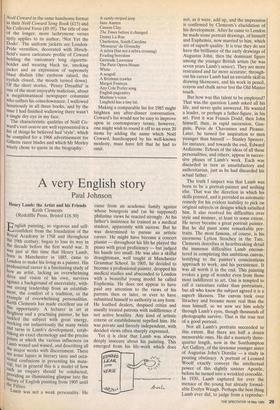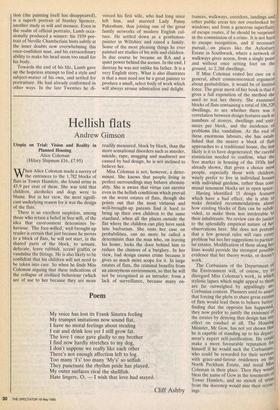A very English story
Paul Johnson
Henry Lamb: the Artist and his Friends Keith Clements
(Redcliffe Press, Bristol £16.50)
English painting, so vigorous and self- confident from the foundation of the Royal Academy in 1768 and throughout the 19th century, began to lose its way in the decade before the first world war. It was just at this time that Henry Lamb, born in Manchester in 1885, came to London to make his living as a painter. His Professional career is a fascinating study of how an artist, lacking an overwhelming drive and vision of his own, survives against a background of uncertainty, with- out strong leadership from an establish- ment, the comfort of a tradition, or the example of overwhelming personalities. Keith Clements has made excellent use of this opportunity. A lecturer in art at Brighton and a practising painter, he has tackled the subject with great energy, Working out industriously the many twists and turns in Lamb's development, estab- lishing an exa,:t chronology and the precise Points at which the various influences on Lamb waxed and waned, and describing all the major works with discernment. There are some lapses in literary taste and occa- sional confusions in presenting his mate- rial, but in general this is a model of how such an enquiry should be conducted, .r oviding an illuminating glimpse into the uistory of English painting from 1905 until the Fifties.
Lamb was not a weak personality. He
came from an academic family against whose bourgeois and (as he supposed) philistine views he reacted strongly. At his father's insistence he trained as a medical student, apparently with success. But he was determined to pursue an artistic career. He might have become a concert pianist — throughout his life he played the piano with great proficiency — but judged his hands too small. He was also a skilful draughtsman, well taught at Manchester Grammar School. In 1905, he decided to become a professional painter, dropped his medical studies and absconded to London with a beautiful young model he called Euphemia. He does not appear to have paid any attention to the views of his parents then or later, or ever to have submitted himself to authority in any form. He loathed dealers, despised critics and usually treated patrons with indifference if not active hostility. Any kind of artistic coterie or establishment repelled him. He was private and fiercely independent, with decided views often sharply expressed.
Yet it is clear that Lamb was always deeply insecure about his painting. This emerged from his life-work which does not, as it were, add up, and the impression is confirmed by Clements's elucidation of his development. After he came to London he made some portrait drawings, of himself and Euphemia, now married to him, which are of superb quality. It is true they do not have the brilliance of the early drawings of Augustus John, then the dominant figure among the younger British artists (he was seven years Lamb's senior). They are more restrained and far more accurate; through- out his career Lamb had an enviable skill in drawing likenesses, and his work in pencil, crayon and chalk never lost the Old Master touch.
But how was this talent to be employed? That was, the question Lamb asked all his life, and never quite answered. He wanted a leader, or perhaps a father-figure, in his art. First it was Francis Dodd; then John himself; then, in rapid succession, Gau- guin, Puvis de Chavannes and Picasso. Later, he turned for inspiration to men younger than himself — Stanley Spencer, for instance, and towards the end, Edward Ardizzone. Echoes of the ideas of all these personalities, and others, appear in succes- sive phases of Lamb's work. Each was discarded in turn as unsatisfactory and authoritarian, just as he had discarded his actual father.
The truth I suspect was that Lamb was born to be a portrait-painter and nothing else. That was the direction in which his skills pointed, and it provided an automatic remedy for his evident inability to pick on original subjects or designs which satisified him. It also resolved his difficulties over style and manner, at least to some extent. He never became a great portrait painter. But he did paint some remarkable por- traits. The most famous, of course, is his enormous Lytton Strachey in the Tate. Clements describes in heartbreaking detail the immense difficulties Lamb encoun- tered in completing this ambitious canvas, testifying to the painter's conscientious approach to work, and his persistence. It was all worth it in the end. This painting evokes a gasp of wonder even from those most indifferent to art. One is tempted to call it caricature rather than portraiture, but all who knew the subject agreed it is a superb likeness. The canvas took over Strachey and became more real than the man himself, so we now see him solely through Lamb's eyes, though thousands of photographs survive. That is the true test of a good portrait.
Not all Lamb's portraits succeeded to this extent. But there are half a dozen memorable ones. He did a masterly three- quarter length, now in the Southampton Art Gallery, of the tiresome younger sister of Augustus John's Dorelia — a study in pouting obstinacy. A portrait of Leonard Woolf exactly conveys the intellectual power of this slightly sinister Apostle, before he turned into a wrinkled crocodile. In 1930, Lamb captured for ever the menace of the .young but already formid- able Evelyn Waugh. Perhaps the best thing Lamb ever did, to judge from a reproduc- tion (the painting itself has disappeared), is a superb portrait of Stanley Spencer, another study in will and menace. Even in the realm of official portraits, Lamb occa- sionally produced a winner: his 1939 por- trait of Neville Chamberlain hints subtly at the inner doubts now overwhelming this once-confident man, and his extraordinary ability to make his head seem too small for his body.
Towards the end of his life, Lamb gave up the hopeless attempt to find a style and' subject-matter of his own, and settled for portraiture. He had already conformed in other ways. In the late Twenties he di- vorced his firt wife, who had long since left him, and married Lady Pansy Pakenham, thus joining one of the great family networks of modern English cul- ture. He settled down as a gentleman- painter in Wiltshire and raised a family. Some of the most pleasing things he ever painted are studies of his wife and children. In due course he became an RA and a quiet power behind the scenes. In the end, I daresay he was not unlike his father. It is a very English story. What is also illustrates is that a man need not be a great painter to produce a small, select body of work which will always arouse admiration and delight.















































 Previous page
Previous page